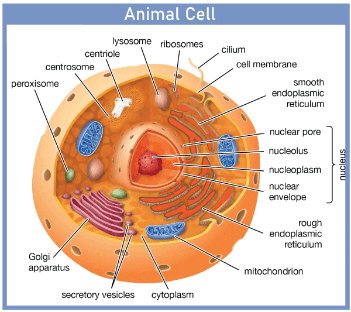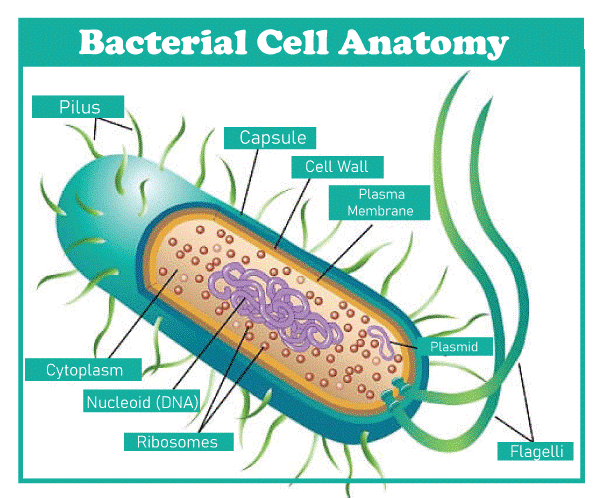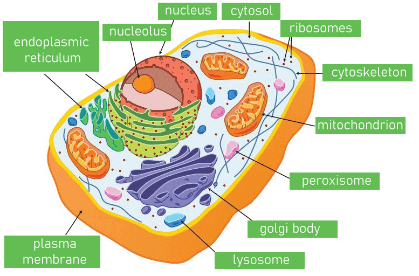Cell DefinitionThe cell is the smallest and basic unit of life that backs all the processes needed to carry out life. It is the structural, functional, and biological unit of all the living entities on the earth. The cells are very much able to multiply themselves, thus known as building blocks of life. Also, every cell has a fluid called cytoplasm enclosed within a membrane. Cytoplasm consists of various biomolecules like proteins, nucleic acids and lipids. Also, within the cytoplasm, cellular structures are known as cell organelles. Cell Biology refers to the study of cells from their basic form to each cell organelle. The first biologist to study cells was Robert Hooke. The smallest cells present among living beings are mycoplasmas. Organisms can be made up of a single cell or multiple cells. Organisms made up of a single cell are known as unicellular organisms, and those made up of multiple cells are known as multicellular organisms. Cells provide shape, form, and physical structure to the body and convert food into energy. There are numerous cells present in the body. Different cells are seen in different forms, sizes, and shapes and perform different functions. Each cell has various components in it which perform a specific function. The number or count of cells varies from one organism to another. Human being tends to have more cells as compared to that bacteria. 
Discovery of the cellRobert Hooke found the cell in 1665. Robert Hooke noticed a piece of container plug under a compound magnifying instrument and saw tiny designs that helped him to remember little rooms. This way, he named these "rooms" cells. In any case, his compound magnifying lens had restricted amplification, and thus, he was unable to see any subtleties in the construction. Inferable from this impediment, Hooke inferred that these were non-living substances. Later Anton Van Leeuwenhoek noticed cells under one more compound magnifying instrument with higher amplification. This time, he noticed that the cells displayed some development (motility). Subsequently, Leeuwenhoek reasoned that these infinitesimal elements were "alive." In the long run, these substances were named animalcules after a large group of different perceptions. In 1883, Robert Brown, a Scottish botanist, gave the initial bits of knowledge into the cell structure. He had the option to portray the core present in the cells of orchids. Features of a cellThe following are the different fundamental attributes of cells:
Functions of a cellA cell carries out various significant roles fundamental for developing and improving an organic entity. Significant elements of the cell are as per the following: 1. Offers help and designEvery one of the life forms is comprised of cells. They structure the primary premise of the multitude of living beings. The cell wall and the cell film are the primary parts that capability of offering help and design to the organic entity. E.g. the skin is comprised of countless cells. The xylem in vascular plants is made of cells that offer underlying help to the plants. 2. Work with development MitosisDuring the time spent in mitosis, the parent cell partitions into the little girl cells. Consequently, the cells duplicate and work with the development of a living being. 3. Permits transport of substancesDifferent supplements are imported by the cells to do different compound cycles happening inside the cells. The waste created by the synthetic cycles is dispensed from the cells by dynamic and aloof vehicles. Little particles like oxygen, carbon dioxide, and ethanol diffuse across the cell film along the focus angle. The bigger particles diffuse across the cell layer through dynamic vehicles where the cells require energy to move the substances. This is known as an inactive vehicle. 4. Energy creationCells needs energy to complete different synthetic cycles. The phones deliver this energy through a cycle called photosynthesis in plants and breathing in creatures. 5. Supports multiplicationA cell supports multiplication through the cycles called mitosis and meiosis. Mitosis is named the agamic generation, where the parent cell partitions to frame girl cells. Meiosis makes the girl cells hereditarily not the same as the parent cells. Different types of cellsCells are like plants with various workers and offices that work towards a specific goal. Different sorts of cells carry out various roles. In light of cell structure, there are basically two kinds of cells:
Prokaryotic cells
Eukaryotic cells
The structure of a cellThe cell structure contains individual parts with explicit capabilities crucial for life's cycles. These parts incorporate the cell wall, cell membrane, cytoplasm, nucleus, and cell organelles. Cell membrane
Cell wall
Cytoplasm
Nucleus
The mitochondria and the chloroplastThe centers of power in a cell are the mitochondria and chloroplasts. Animal and plant cells have mitochondria, which are elongated cylindrical structures around one micrometer long and densely packed in areas where metabolic energy is being used. The cytoplasmic metabolic by-products are oxidized in mitochondria to produce adenosine triphosphate (ATP), the cellular energy currency. The photosynthetic organelles in plants and some algae are called chloroplasts. They capture light energy and partially transform it into ATP, but primarily into a few chemically reduced molecules combined with ATP to form the early stages of the creation of carbohydrates. Both mitochondria and chloroplasts have a structural similarity and function similarly independently within the cell, producing some proteins using DNA instructions. The cytoskeletonThe term "cytoskeleton" refers to the network of long protein filaments present throughout eukaryotic cells' cytoplasm and constitute a fibrous structure (cells containing a nucleus). The cytoskeleton's filaments build a scaffold, or framework, that arranges other cell components and preserves the cell's form. Moreover, some filaments cause the cell and its internal organelles to move in a coordinated manner. Prokaryotic (non-nucleated) cells, typically considerably smaller than eukaryotic cells, include a special group of similar filaments but lack real cytoskeletons in most cases. Actin filaments, microtubules, intermediate filaments, and septins are the four main categories of cytoskeletal filaments that are typically identified. In most cells, actin filaments and microtubules are dynamic structures that constantly build and disintegrate. Intermediate filaments are more stable and appear to play a major role in supporting cellular structures, particularly the location of the nucleus and cell-to-cell junctions. Septins have also been linked to other cellular processes outside of cell division. Each type of filament cooperates with a vast range of accessory proteins that connect the filaments and the cell membrane, forming the networks that give the cytoskeleton its distinct roles. As many of these auxiliary proteins have been described, a wide range in their structure and function of the cytoskeleton. Cell division and growthCell division is the process by which unicellular creatures reproduce, whereas, in multicellular organisms, it is the process by which tissues grow and are maintained. Maintaining a balanced distribution of cell types is crucial because interactions between various cell types are vital for the survival of eukaryotes. Cell growth, a well-controlled process, enables this. Although cell populations have various systems for controlling their growth and division, multicellular organisms often share the same fundamental principles. Most body tissues expand by adding more cells, although this expansion is tightly controlled to preserve the harmony of various tissues. In adults, tissue renewal rather than growth is the primary focus of cell division, with many different cell types undergoing constant replacement. For instance, skin cells are continuously shed and replaced; in this instance, fully differentiated cells do not divide, but the division of immature stem cells replenishes their number. Some mature cells can still divide to support development or regeneration after damage in some tissues, such as the liver. In contrast to these patterns, some cell types are either unable to divide or are stopped from doing so by specific chemicals produced by neighbouring cells. As a result, some tissues in the adult body have a significantly decreased capacity to replace damaged or unhealthy cells. Heart muscle, central nervous system nerve cells, and mammalian lens cells are a few examples of such tissues. These cells can only be maintained and repaired by replacing intracellular components, not whole cells. Cell differentiationMature organisms are made up of various cell types. The arrangement of cells results in tissues, each of which has a limited number of cell types and is dedicated to a certain physiological function. For instance, the epithelial tissue lining the small intestine has columnar absorptive cells, goblet cells that secrete mucus, endocrine cells that secrete hormones, and Paneth cells that secrete enzymes. In addition, undifferentiated dividing cells lie in the crypts between the intestinal villi and replace the other cell types when they become damaged or worn out. Another example of a differentiated tissue is the skeletal tissue of a long bone, which contains osteoblasts (large cells that synthesize bone) in the outer sheath and osteocytes (mature bone cells) and osteoclasts (multinucleate cells involved in bone remodelling) within the matrix.
Next TopicCharges Definition
|
 For Videos Join Our Youtube Channel: Join Now
For Videos Join Our Youtube Channel: Join Now
Feedback
- Send your Feedback to [email protected]
Help Others, Please Share










